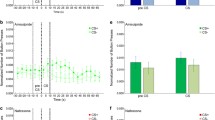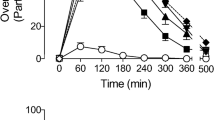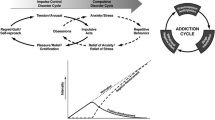Abstract
There has been little study of the abuse liability of ephedrine, a naturally occurring drug used in medicine for thousands of years and currently sold as a “legal” stimulant. The present study measured the reinforcing and subjective effects of ephedrine in a group of 27 adults (18 females and 9 males) with no history of drug dependence. A discrete-trial choice procedure was used to assess the reinforcing effects of a single oral dose of ephedrine selected to produce a moderate subjective response in each subject (range: 37.5-75 mg). A number of variables (gender, current and past drug use, personality, and baseline mood and arousal) were examined in an attempt to identify sources of variability in response to ephedrine. Of the 27 subjects, 5 chose ephedrine on either 2 or 3 out of a possible 3 occasions; overall, ephedrine was chosen on 17% of occasions. In the group as a whole, ephedrine had no effect on ratings of drug liking, but did increase ratings of “high” and scores on the MBG (“euphoria”) scale of the Addiction Research Center Inventory. Ephedrine also increased scores on a number of mood scales reflecting CNS stimulation and anxiety. Ephedrine choice was positively associated with current use of marijuana and lower levels of baseline anxiety and hunger, as well as with lower scores on two scales measuring dimensions of the personality trait of harm avoidance. Males and females differed in their response to ephedrine — males chose ephedrine more frequently than females and showed a more positive mood response to the drug. When compared to the results of a prior study of the same design withd-amphetamine, these results demonstrate that ephedrine produces a different profile of subjective effects and is a less efficacious reinforcer than amphetamine, suggesting that ephedrine has a lower liability for abuse.
Similar content being viewed by others
References
Ando K, Yanagita T (1992) Effects of an antitussive mixture and its constituents in rats discriminating methamphetamine from saline. Pharmacol Biochem Behav 41:783–788
Angrist B, Rotrosen J, Kleinberg D, Merriam V, Gershon S (1977) Dopaminergic agonist properties of ephedrine — theoretical implications. Psychopharmacology 55:115–120
Carroll ME, Meisch RA (1984) Increased drug-reinforced behavior due to food deprivation. In: Thompson T, Dews PB, Barrett JE (eds) Advances in behavioral pharmacology, vol 4. Academic Press, New York, pp 47–88
Chait LD (1992) Factors influencing the subjective response to caffeine. Behav Pharmacol 3:219–228
Chait LD (1993) Factors influencing the reinforcing and subjective effects ofd-amphetamine in humans. Behav Pharmacol 4:191–199
Chait LD, Uhlenhuth EH, Johanson CE (1987) Reinforcing and subjective effects of several anorectics in normal human volunteers. J Pharmacol Exp Ther 242:777–783
Chait LD, Uhlenhuth EH, Johanson CE (1988) Phenylpropanolamine: reinforcing and subjective effects in normal human volunteers. Psychopharmacology 96:212–217
Chen KK, Schmidt CF (1930) Ephedrine and related substances. Medicine 9:1–117
Cloninger CR (1987) A systematic method for clinical description and classification of personality variants. Arch Gen Psychiatry 44:573–588
Derogatis LR, Lipman RS, Covi L (1973) SCL-90: An outpatient psychiatric rating scale — preliminary report. Psychopharmacol Bull 9:13–17
Eysenck HJ, Eysenck SBG (1968) Manual for the Eysenck Personality Inventory. Educational and Industrial Testing Service, San Diego
Gauvin DV, Harland RD, Michaelis RC, Holloway FA (1989) Caffeine-phenylethylamine combinations mimic the cocaine discriminative cue. Life Sci 44:67–73
Gauvin DV, Moore KR, Youngblood BD, Holloway FA (1993) The discriminative stimulus properties of legal, over-the-counter stimulants administered singly and in binary and ternary combinations. Psychopharmacology 110:309–319
Goodstadt MS, Cook G, Magid S, Gruson V (1978) The drug attitudes scale (DAS): its development and evaluation. Int J Addict 13:1307–1317
Griffiths RR, Brady JV, Bradford LD (1979) Predicting the abuse liability of drugs with animal drug self-administration procedures: psychomotor stimulants and hallucinogens. In: Thompson T, Dews PB (eds) Advances in behavioral pharmacology, vol 2. Academic Press, New York, pp 163–208
Hoffman BB, Lefkowitz RJ (1990) Catecholamines and sympathomimetic drugs. In: Gilman AG, Rall TW, Nies AS, Taylor P (eds) The pharmacological basis of therapeutics. Pergamon Press, New York, pp 187–220
Holloway FA, Michaelis RC, Huerta PL (1985) Caffeinephenylethylamine combinations mimic the amphetamine discriminative cue. Life Sci 36:723–730
Huang J-T, Ho BT (1974) Discriminative stimulus properties ofd-amphetamine and related compounds in rats. Pharmacol Biochem Behav 2:669–673
Johanson CE, Kilgore K, Uhlenhuth EH (1983) Assessment of dependence potential of drugs in humans using multiple indices. Psychopharmacology 81:144–149
Kalix P (1991) The pharmacology of psychoactive alkaloids from Ephedra and Catha. J Ethnopharmacol 32:201–208
Martin WR, Sloan JW, Sapira JD, Jasinski DR (1971) Physiologic, subjective and behavioral effects of amphetamine, methamphetamine, ephedrine, phenmetrazine, and methylphenidate in man. Clin Pharmacol Ther 12:245–258
McNair DM, Lorr M, Droppleman LF (1971) Manual for the Profile of Mood States. Educational and Industrial Testing Service, San Diego
Schutz RW, Gessaroli ME (1987) The analysis of repeated measures designs involving multiple dependent variables. Res Q Exercise Sport 58:132–149
Stern KN, Chait LD, Johanson CE (1989) Reinforcing and subjective effects of caffeine in normal human volunteers. Psychopharmacology 98:81–88
Thayer RE (1989) The biopsychology of mood and arousal. Oxford University Press, New York
Zuckerman M, Eysenck S, Eysenck HJ (1978) Sensation seeking in England and America: cross-cultural, age and sex comparisons. J Consult Clin Psychol 46:139–149
Author information
Authors and Affiliations
Rights and permissions
About this article
Cite this article
Chait, L.D. Factors influencing the reinforcing and subjective effects of ephedrine in humans. Psychopharmacology 113, 381–387 (1994). https://doi.org/10.1007/BF02245213
Received:
Revised:
Issue Date:
DOI: https://doi.org/10.1007/BF02245213




